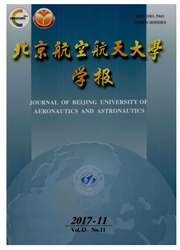

 中文摘要:
中文摘要:
大展弦比飞翼构型取消了垂尾和方向舵,通常采用开裂式方向舵和多组升降副翼组合来实现滚转和偏航操纵.通过与常规的侧力类方向舵对比,揭示了阻力类开裂式方向舵的操纵机理,包括偏航和滚转力矩产生原理以及操纵效能等.对大展弦比飞翼构型的横航向配平能力和协调机动能力进行了分析,并与常规飞机进行了对比,研究结果表明单发失效对偏航操纵效能要求最高,需要适当地增加开裂式方向舵的舵容量或对现有布局进行改进设计.
 英文摘要:
英文摘要:
High aspect-ratio flying wing configurations usually use split-drag-rudder (SDR) and a set of elevons to fulfill the lateral-directional control, without the traditional vertical tail and rudder. The control characteristics of SDR were specially researched, including the generation of the roll and yaw control moments and the control power effects, compared with the conventional side-force-rudder. The ability and characteris- tics of the yaw and roll control of high aspect-ratio flying wing configurations were presented, including lateraldirectional control trimming and maneuver coordination. And the differences between the conventional aircraft configurations and flying wing configurations were emphatically analyzed. Evaluation data show that single-engine-out is the most critical case for directional control and the yaw control effect requirement is beyond what SDR can provide. As a result, the control volume of SDR ought to be properly increased or the current flying wing configuration needs improving.
 同期刊论文项目
同期刊论文项目
 同项目期刊论文
同项目期刊论文
 期刊信息
期刊信息
